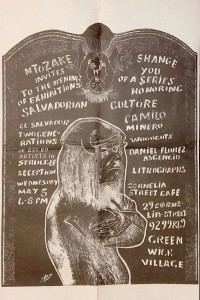BAM, Multiculturalism & the “Languages” of Ntozake Shange
Black, white Chicana/o, and Asian American artists within the avant-garde theater movement shared similar interests in popular theatrical forms, particularly satire and farce, as well as nonnaturalist and often non -European dramatic norms that emphasized gesture, ritual and spectacle over plot and character development– Edward Smethurst “Bandung World . . .” 264
Well, this has been quite a week! I heard that the Friday session was quite exciting. Thanks again to Tiana and
Richard Wright’s essays reporting on the 1955 Bandung Conference: “They were getting a new sense of themselves, getting used to new roles and new identities.”
Sydnie for leading the group whike I was across the street talking about race and the seventeenth century stage. When I put together the syllabus, I had grouped several BAM-linked phenomena through the rubric “Decolonization,” perhaps because when I was writing it, I was thinking about how the decolonization movements of the 50s, particularly the 1955 Bandung Conference, an Afro-Asian conference of 29 African and Asian nations that excluded the Western powers, set the stage for the Black Power Movement and other liberation movements.
Malcolm X saw Bandung as a model for black unity. Tellingly, SOS includes the statement of principles that came out of Bandung, marking the importance of Bandung as a moment of cross-racial, transnational moment of solidarity around issues of political and cultural self-determination, end of race discrimination, cultural empowerment that we have seen as key to the Black Power/Black Arts Movement.
However, what I hope to get out of the readings from Thursday is an expansive sense of the influences on Ntozake as a rebellious “daughter of the Black Arts Movement” who came of artistic age at a time of rich interchange between East and West Coast activists/artists and was specifically influenced by the “multicultural” and cultural nationalist movements that were fermenting on the West Coast.
As you know from Lost in Language and Sound, Shange moved to the West coast after Barnard. where she was a key part of the multicultural movements, Third World feminist, bohemian, and avant garde communities active, particularly in San Francisco/Bay Area. The chapter from Smethurst gives you some sense of the linkages between these communities. When we read Sassafras, Cypress and Indigo and Harryettte Mullin’s essay, her positions within these communities will be more tangible. Shange was dancing with the group around Jazz performer/Afrofuturist Sun-Ra and his Arkestra, but she also belonged to a Third World Woman’s Cooperative (The Third World Women’s Alliance?) and feminist groups with Jessica Hagedorn and other women writers of color. As I said on the first day, this course focuses more on the Black Arts Movement and the next iteration will focus on feminisms; however, one takeaway for us in these readings is that the Black Power and Black Arts Movements were much more consciously linked to other liberation movements than we tend to recognize today. (Recently, someone who tookSun Ra’s 1971 UC-Berkeley course, “The Black Man in the Cosmos” reconstructed his syllabus.)
My aim is to show how the tension between these two attitudes to language brings Shange to practice multilingualism in her poetry and performance pieces in order to situate herself and her writing outside of the limited national community. Anita Sprya 786
Ntozake gave us the other takeaway herself on Thursday. when she told us how important multilingualism was to her as both artistic practice and personal politics. So too, she noted that she preferred to teach black women’s literatures multicultural feminist in the context of work by other women of color. Although they take different approaches to her work, Soyica Diggs, Anita Spyra and Vanessa Valdes all suggest that multilingualism is one of the ways Ntozake refuses nationalism, whether the colonial/imperial force of the nation-state or the didactic cultural nationalism of Back Power/BAM.

Poster from a 1982 event at the Cornelia Street cafe in support of Salvadoran artists-a tangible example of her Latin-American connections
Since we are reading a lot of dense cultural history about links between the Black Arts Movement and other movements in Smethurst and the Wilkinson and Hernandez essays from New Thoughts on the Black Arts Movement, its perhaps its a good time to loop back to some of the poetry in A Daughter’s Geography, you already have From Okra to Greens, but I am including excerpts that include “Hijo de Las Americas”
From SOS:
- The Asian-African Conference, Final Communique: Cultural Communication, 203
- Third World Press, A Statement of Purpose 227
- UMBRA foreword to Issue 1.1 232
- Soulbook, To the Peoples of Afroamerica, Africa, and to all the Peoples of the World, 223
From A Daughter’s Geography:
- Bocas: A Daughter’s Geography
- tween Itaparica and Itapuã
- A Black Night In Haiti, Palais National, Port-au-prince.
- New World Coro
- Hijo de Las Americas
Class business:
I am beginning to feel like we need a class to process the archival conversations we are beginning, which might mean canceling Spell #7. which I think is a brilliant and understudied piece–but perhaps it can be the subject of a Twitter class next semester.

